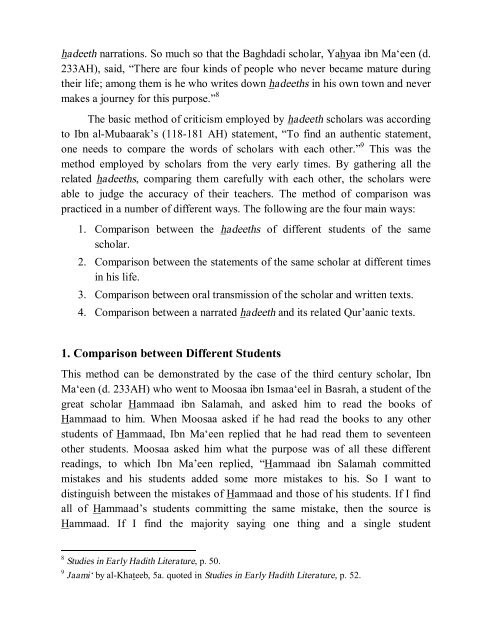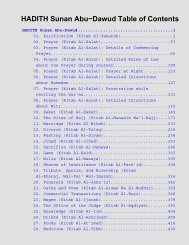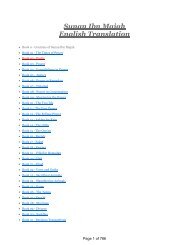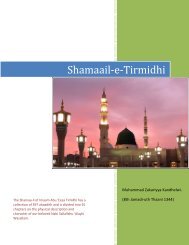SIX: CriticismBy hadeeth criticism is meant the Science of V<strong>al</strong>idation of Hadeeth (‘Ilm <strong>al</strong>-Jarhwa at-Ta‘deel), whereby hadeeths are ruled to be reliable or inv<strong>al</strong>id based oncertain criteria. The effort to distinguish between narrations from the Prophet (r),was rooted in his warning, “If anyone tells a lie about me intention<strong>al</strong>ly, let him besure of his place in the hell fire.” 1 This process began during the lifetime of theProphet (r) himself. However, at this stage, it meant no more than going to theProphet (r) and verifying something he was reported to have said. Dimaam ibnTha‘labah came to the Prophet (r) on one occasion and asked, “Muhammad,your messenger came to us and told us so and so.” The Prophet (r) replied, “Hetold you the truth.” 2A similar form of investigation or verification was reported to have beencarried out by ‘Alee, 3 Ubayy ibn Ka‘b, 4 ‘Abdullaah ibn ‘Amr, 5 ‘Umar, 6 Zaynabwife of Ibn Mas‘ood 7 and others. Although the process of asking the Prophet (r)ceased with his death, the first C<strong>al</strong>iph, Aboo Bakr, ‘Umar and ‘Alee as well asother companions like ‘Aa’ishah and Ibn ‘Umar continued these efforts ofhadeeth criticism. With the turmoil which came at the end of C<strong>al</strong>iph ‘Uthmaan’sreign and throughout the rule of C<strong>al</strong>iph ‘Alee, scholars among the students of theCompanions became very strict in the transmission of hadeeths. Scholars amongthe students of the Companions continued the hadeeth criticism efforts, likeSa‘eed ibn <strong>al</strong>-Musayyab (d. 93 AH); Sa<strong>al</strong>im ibn ‘Abdillaah ibn ‘Umar (d.106AH); ‘Alee ibn Husayn ibn ‘Alee (d. 93AH); and ‘Urwah ibn az-Zubayr (d.94AH). Among their students in the second century after the Hijrah, threescholars stood out in the region of Madeenah, az-Zuhree (d. 124AH), Yahyaa ibnSa‘eed and Hishaam ibn ‘Urwah. During the periods of the second and thirdcenturies, scholars became noted for their extensive travels in the search for1 Saheeh Al Bukhaaree, ‘ilm, 38.2 Saheeh Muslim, Iman, 10 and Saheeh Al Bukhaaree, ‘ilm 6.3 Sunan an-Nasaa’e, vol. V. III4 Musnad Ahmad, v. 143.5 Saheeh Al Bukhaaree, magazi, 256 Muslim, musafirin, 17 Saheeh Al Bukhaaree, zakat, 44
hadeeth narrations. So much so that the Baghdadi scholar, Yahyaa ibn Ma‘een (d.233AH), said, “There are four kinds of people who never became mature duringtheir life; among them is he who writes down hadeeths in his own town and nevermakes a journey for this purpose.” 8The basic method of criticism employed by hadeeth scholars was accordingto Ibn <strong>al</strong>-Mubaarak’s (118-181 AH) statement, “To find an authentic statement,one needs to compare the words of scholars with each other.” 9 This was themethod employed by scholars from the very early times. By gathering <strong>al</strong>l therelated hadeeths, comparing them carefully with each other, the scholars wereable to judge the accuracy of their teachers. The method of comparison waspracticed in a number of different ways. The following are the four main ways:1. Comparison between the hadeeths of different students of the samescholar.2. Comparison between the statements of the same scholar at different timesin his life.3. Comparison between or<strong>al</strong> transmission of the scholar and written texts.4. Comparison between a narrated hadeeth and its related Qur’aanic texts.1. Comparison between Different StudentsThis method can be demonstrated by the case of the third century scholar, IbnMa‘een (d. 233AH) who went to Moosaa ibn Ismaa‘eel in Basrah, a student of thegreat scholar Hammaad ibn S<strong>al</strong>amah, and asked him to read the books ofHammaad to him. When Moosaa asked if he had read the books to any otherstudents of Hammaad, Ibn Ma‘een replied that he had read them to seventeenother students. Moosaa asked him what the purpose was of <strong>al</strong>l these differentreadings, to which Ibn Ma’een replied, “Hammaad ibn S<strong>al</strong>amah committedmistakes and his students added some more mistakes to his. So I want todistinguish between the mistakes of Hammaad and those of his students. If I find<strong>al</strong>l of Hammaad’s students committing the same mistake, then the source isHammaad. If I find the majority saying one thing and a single student8 Studies in Early <strong>Hadith</strong> Literature, p. 50.9 Jaami‘ by <strong>al</strong>-Khateeb, 5a. quoted in Studies in Early <strong>Hadith</strong> Literature, p. 52.
- Page 2:
[Usool Al Hadeeth]The Methodology o
- Page 6 and 7:
from the Prophet of his actions, sa
- Page 8 and 9:
3. LawsOne of the primary duties of
- Page 10 and 11:
authentically attributable to the P
- Page 12 and 13:
was asked which city will be conque
- Page 14 and 15:
Rahmaan, who was at that time the m
- Page 16 and 17:
centuries. They also grouped the ha
- Page 18 and 19:
Prophet's lifetime, and in the wars
- Page 20 and 21:
JAABIR IBN ‘ABDILLAAH. One of the
- Page 22 and 23:
2. ‘Ard : Reading by the Students
- Page 24 and 25:
Transmission TerminologyThe hadeeth
- Page 26 and 27:
EVOLUTION OF THE SANADTeaching the
- Page 28 and 29:
the Sahaabah had left off and began
- Page 30 and 31:
In this case the Sanad is shorter b
- Page 32 and 33:
The Pattern of IsnaadThe usual patt
- Page 35 and 36: Origins of the Isnaad SystemEvery t
- Page 37 and 38: FOUR: ClassificationDue to a variet
- Page 39 and 40: Hadeeth SaheehA hadeeth must meet t
- Page 41 and 42: Saheeh li GhayrihThe hadeeth saheeh
- Page 43 and 44: ecorded by others.5. Authentic hade
- Page 45 and 46: Abee Awfaa wrote to him saying that
- Page 47 and 48: Muhammad ibn Bashshaar informed us
- Page 49 and 50: Ruling on Da‘eef NarrationsSchola
- Page 51 and 52: In this narration, he deleted the c
- Page 53 and 54: called Taghleeq at-Ta‘leeq (Closi
- Page 55 and 56: The jurists (fuqahaa) generally def
- Page 57 and 58: Caesar’s emissary collected by Ah
- Page 59 and 60: Muwatta 42 with the following chain
- Page 61 and 62: Saqiyah called him Aboo Wahb al-Asa
- Page 63 and 64: Khateeb al-Baghdaadee’s book call
- Page 65 and 66: The Mu’annan is a hadeeth in whic
- Page 67 and 68: and the household of the Prophet (r
- Page 69 and 70: The supporters of each opinion fabr
- Page 71 and 72: (Soorah al-Israa, 17: 79) he said t
- Page 73 and 74: 7. Inventions for Personal Motives:
- Page 75 and 76: Zamakhasharee and ash-Shawkaanee.Li
- Page 77 and 78: definitions by other scholars are:1
- Page 79 and 80: FIVE: ConflictIn vast number of nar
- Page 81 and 82: farewell Hajj as well as on other o
- Page 83: caught) but on the fourth occasion
- Page 87 and 88: Mulaykah, 14 az-Zuhree 15 and Shu
- Page 89 and 90: them in ash-Sha‘bee’s direction
- Page 91 and 92: ased on the relative reliability of
- Page 93 and 94: Step Four: The eras of the narrator
- Page 95 and 96: ) متواتِر بِال ْمعن
- Page 97 and 98: have even claimed Ijmaa‘ (unanimi
- Page 99 and 100: What further explains this Qur’aa
- Page 101 and 102: Bukhaaree - the most correct book a
- Page 103 and 104: 3. ‘Abdullaah ibn ‘Umar said:
- Page 105 and 106: of scholars. It is false because it
- Page 107 and 108: This hadeeth was narrated from Anas
- Page 109 and 110: the view that discrepancies between
- Page 111 and 112: EIGHT: LiteratureThe origins of the
- Page 113 and 114: collected hadeeths which were relat
- Page 115 and 116: Ibn Hambal began lecturing on tradi
- Page 117 and 118: students, and also to his sons and
- Page 119 and 120: The final chapter is on Shamaa’il
- Page 121 and 122: On many occasions al-Bukhaaree’s
- Page 123 and 124: Saheeh of Muslim ibn al-Hajjaaj ibn
- Page 125 and 126: have examined 500,000 hadeeths, and
- Page 127 and 128: Islamic world. 43 Sunan Abee Daawoo
- Page 129 and 130: them on account of its isnaad. I he
- Page 131 and 132: Muslim. 56 The book does, however,
- Page 133 and 134: Ad-Daaraqutnee rapidly acquired a s
- Page 135 and 136:
men had to be appointed to repeat h
- Page 137 and 138:
The Zawaa’id Work of al-Haythamee
- Page 139 and 140:
(iv) They had been used as a basis
- Page 141 and 142:
the well-known Kitaab al-Ansaab of
- Page 143 and 144:
notices of more than 40,000 narrato
- Page 145 and 146:
Zaynud-Deen al-‘Iraaqee (725-806/
- Page 147 and 148:
forced to leave the city and wander
- Page 149 and 150:
the author. But the work could not
- Page 151 and 152:
TEN: Women Scholars of HadeethHisto
- Page 153 and 154:
daughter of the distinguished juris
- Page 155 and 156:
turn lectured to many students, som
- Page 157 and 158:
excelled in the art of calligraphy
- Page 159 and 160:
occurs only in Mutayyin’s narrati
- Page 161 and 162:
Abu Bakr as-Siddeeq, then to Ali ib
- Page 163 and 164:
ف َأ َمسك َها ف َل
- Page 165 and 166:
Haakim, Muhammad ibn ‘Abdillaah a
- Page 167:
Thahabee, Muhammad ibn Ahmad ath-.





